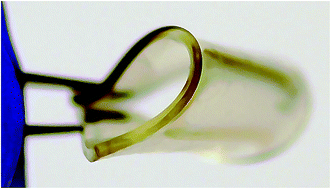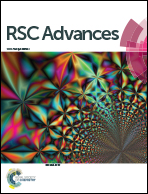Transparent, stretchable, and conductive SWNT films using supramolecular functionalization and layer-by-layer self-assembly†
Abstract
We demonstrate films of single-walled carbon nanotubes (SWNTs) on the elastomer polydimethylsiloxane (PDMS) that are stretchable, conductive, and transparent. Our fabrication method uses the supramolecular functionalization of SWNTs with conjugated polyelectrolytes to generate aqueous dispersions of positively- and negatively-charged SWNTs, followed by layer-by-layer self-assembly onto a PDMS substrate. Adding bilayers of positively- and negatively-charged SWNTs to the surface causes the sheet resistance and the % transmittance of the film to both progressively decrease. The sheet resistance decreases sharply in the first five bilayers as the layer-by-layer process efficiently establishes the percolation network, whereas the % transmittance declines more gradually. Films with 25 bilayers are transparent (75% at 550 nm) and conductive (560 ± 90 Ω □−1). The combination of electrostatic and π-stacking forces very effectively bind the SWNTs within the film, producing smooth film surfaces (root-mean-square roughness of 18 nm) and enabling the films to remain conductive up to 80% elongation. We demonstrate the use of the SWNT films as transparent conductive electrodes in light-emitting devices and as soft strain sensors that are both wearable and transparent.


 Please wait while we load your content...
Please wait while we load your content...